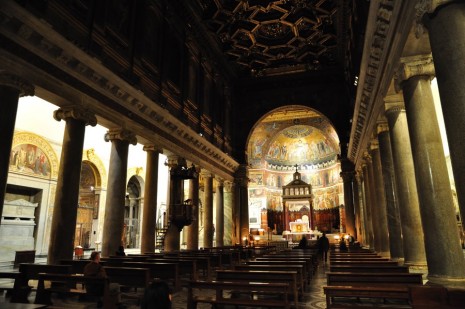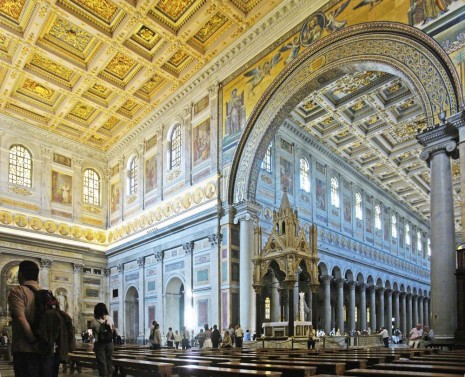The liturgy at this conference had been really beautiful. Yesterday we celebrated Mass in the basilica of Santa Maria in Trastevere, today we celebrated Mass in the basilica of St Paul Outside the Walls, and tomorrow we return to St Peter’s Basilica.
A mixed choir from Ireland, the Lassus Scholars, have lead the music at all the conference liturgies. They are outstanding. A sublime mix of plainchant, mediaeval polyphony, and traditional Christmas carols. Sacred music has an extraordinary ability to raise the mind and heart to God.
The beauty of the churches we have prayed in are also a great aid to prayer. But it’s not just the beauty – it’s also the historicity of these places. Cardinal Pell preached yesterday, and he began by relating some of the history of Santa Maria in Trastevere.
It is, apparently, the oldest church in Rome, insofar as it was the first “official house of worship” wherein Christians could publicly pray. In the first few centuries of the Church, Christians in Rome worshipped discreetly, and celebrated Sunday Mass in “house churches” – private homes of the faithful.
Parts of the church are so old that they in fact predate Christianity. The pillars in the nave, for example, are salvaged from several pagan temples. It is an old building, and a dark one. There is no natural light. But although it is dark, it is not gloomy – the mosaics in the sanctuary are luminous.
Cardinal Pell evoked the theme of light which imbues Christmas and especially Epiphany, but his words played to the church we were in, too. He suggested that the darkness of paganism may ebb and flow in our world, but it will never overcome the light of Christ, and it’s our task to carry the torch and illuminate the shadows of our time.
These words came back to me at today’s Mass at St Paul’s Outside the Walls. This is a very different church. It less than 200 years old, and it is immensely light and airy. It’s also just plain immense. St Paul’s evokes solidity and permanence.
During Mass today I prayed especially for the victims of yesterday’s Islamist attack in Paris. As I looked around, I pondered how illusory the permanence of this church is. I contemplated not just the physical basilica, but also the faith in Europe, and the freedoms of liberal democracy. All of these things are threatened by the barbarity and violence of Islamism. Islam is not pagan – strictly speaking, it’s a heresy – but it is, nonetheless, the intellectual and spiritual inspiration of a darkness which threatens to spread through Europe and beyond.
As beautiful and big and bright as St Paul’s Basilica is – evocative of Christ, the Alpha and the Omega – I found more consolation in Santa Maria in Trastevere. Especially in its comparative modesty, and in its warm pockets of light which scatter the shadows.
The confidence and brashness and self-assurance of St Paul’s doesn’t suit the present mood, I think. It is warmth and goodness and heroic courage which these times call for, which is evoked not only in the long history of Santa Maria in Trastevere, but also in its very stones: in its architecture and atmosphere.








Were any of the official CCC Masses of the Traditional Rite ?
No. Although there was an EF Mass publicised at the conference, and Confraternity members were invited to attend in choir, it in fact occurred the day after the conference concluded, and it was not part of the official programme.
I would venture to say that a good number of Confraternity priests offer the Extraordinary Form — or intend to. (I’m part of the latter group. One of my new year resolutions is to learn how!) But at least in the case of the Australian Confraternity, we’ve always been careful to “cleave to the mainstream.” Not because there is anything deficient or undesirable about the Traditionalist movement — far from it!!! — but because the Confraternity wishes to attract clergy from all walks of life, be it for example the Traditional Roman Rite, the Charismatic Renewal, the new movements, or (as in my case!) Opus Dei, etc. etc. The Confraternity thereby avoids any niche choices in its official programme which could be an obstacle to others joining.
Now having said all that, given the way things are going among the emerging generations of clergy I’d speculate that in another 25 years times, the Traditional Rite could be part of the official programme. “Mainstream” is a relative concept after all. But that is then, not now.
25 years you think Father !!
My opinion is that if the Mass according to the 1970 Missal commonly known as the Novus Ordo continues to be ‘mainstream’ for the next 25 years there will not be a Church left by then. (One only has to read the statistics of declining numbers of Mass attendances in ‘mainstream’ parishes to agree with this.)
How can you lump “the Traditional Roman Rite, the Charismatic Renewal, the new movements, or (as in your case!) Opus Dei, etc. etc. ” into one group when priests of the Traditional Roman Rite do not prefer the Novus Ordo and the others do ?
I am aware of the small handful of Tradtional Rite priests who do attend the conference. Not including the Traditional Roman Rite Masses into the CCC agenda is not only an insult to these priests but an obstacle to more of them joining.
Have none of these holy priests organising these events read Summorum Pontificum or Universae Ecclesiae ?
Understanding his wonderful intelligence, tolerance and broadmindedness, I am still sure our dear Benedict XVI would be very disappointed to learn of this omission of the Mass of the 1962 Missal as part of the 2015 CCC conference.
In fairness, we didn’t organise a praise and worship session and speak in tongues at the conference either. We didn’t meet Kiko, and we didn’t fit in any circles of doctrinal formation. So when it comes to exclusion, it’s a matter of equal opportunity.
Quite frankly, anyone who is insulted by the Confraternity’s decision would have to choose to be insulted. The absence of these offended hypotheticals (whose actuality is dubious) is probably the Confraternity’s gain.
I don’t think it’s prudent to speak for those Traditionalist priests who are Confraternity members. You misrepresent them I think.